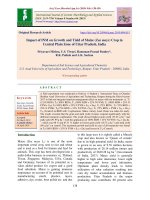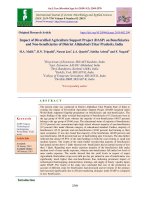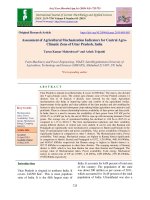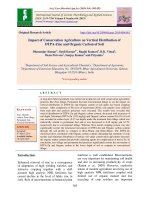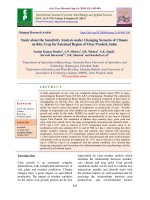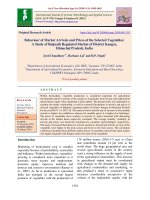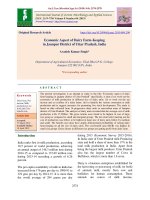Impact of diversified agriculture support project (DASP) on beneficiaries and non-beneficiaries of district Allahabad (Uttar Pradesh), India
Bạn đang xem bản rút gọn của tài liệu. Xem và tải ngay bản đầy đủ của tài liệu tại đây (251.01 KB, 8 trang )
Int.J.Curr.Microbiol.App.Sci (2019) 8(2): 2569-2576
International Journal of Current Microbiology and Applied Sciences
ISSN: 2319-7706 Volume 8 Number 02 (2019)
Journal homepage:
Original Research Article
/>
Impact of Diversified Agriculture Support Project (DASP) on Beneficiaries
and Non-beneficiaries of District Allahabad (Uttar Pradesh), India
H.A. Malik1*, B.N. Tripathi2, Nusrat Jan3, J.A. Quadri4, Sabiha Ashraf5 and F. Naqash6
1
Directorate of Extension, SKUAST-Kashmir, India
2
Agri. Extension, AAI-DU Allahabad, India
3
DoA, Bandipora, Kashmir (J&K), India
4
DoAEx, FoA, SKUAST-K, India
5
College of Temperate Sericulture, SKUAST-K, India
6
DoAE& HBM, SKUAST-K, India
*Corresponding author
ABSTRACT
Keywords
DASP, Impact,
Technological
backstopping,
World Bank, Yield
levels
Article Info
Accepted:
20 January 2019
Available Online:
10 February 2019
The present study was conducted in District Allahabad, Uttar Pradesh State of India to
evaluate the impact of Diversified Agriculture Support Project (DASP) launched under
World Bank supported flagship programme on beneficiaries and non-beneficiaries. The
major findings of the study revealed that majority of beneficiaries (41.33 percent) were in
the age group of 40-50 years whereas the majority of non-beneficiaries (40.67 percent)
belong to the age group of 50-60 years. The educational status of majority of beneficiaries
(23.33 percent) was concentrated upto high school whereas majority of non-beneficiaries
(32 percent) falls under illiterate category of educational standard. Further, majority of
beneficiaries (45.33 percent) and non-beneficiaries (42.00 percent) had farming as their
main occupation. It was also found that majority of the beneficiates (60.00 percent) and
non-beneficiaries (66.66 percent) had size of land holding upto 2 hectares. The data further
reflected that almost 85-95% of the land holdings in both the cases belong to small and
medium farmers. The results of the study further revealed that majority of beneficiaries
had annual income above 3 lakhs whereas non- beneficiaries had an annual income of less
than 3 lakhs. Regarding mass media exposure majority of the beneficiaries falls under
medium level of mass media exposure, whereas non-beneficiaries fall under low level of
mass media exposure. The results showed that the yield levels in respect of major
Agricultural, Horticulture crops even milk per day per animal in case of beneficiaries was
significantly much higher than non-beneficiaries thus indicating prominent impact of
technological backstopping, demonstration, trainings, and supply of timely / quality inputs
under DASP. The results of the study also concluded that cost of the production on
account of different crops for beneficiaries had decreased and net returns of the produce
had increased significantly due to efficient marketing strategies under DASP as compared
to non- beneficiaries.
Introduction
2569
Int.J.Curr.Microbiol.App.Sci (2019) 8(2): 2569-2576
Agriculture
diversification
creates
opportunities for achieving higher and more
stable rural incomes through the efficient use
of resources and the exploitation of
comparative advantage. Keeping it in view, a
new and broader initiative in the form of
Diversified Agriculture Support Project
(DASP) was introduced by the Government
of India for technology development and
dissemination for all round development of
agriculture and allied sectors in two States Uttar Pradesh and Uttaranchal with financial
support from the World Bank. Uttar Pradesh,
being largely agrarian in demographic and
economic terms, no concept of development
could ever be meaningful or worthwhile
without focusing its attention on the
development of Agriculture and allied sectors.
Under this backdrop the Government
launched Diversified Agriculture Support
Project (DASP)with the objective to
accelerate the growth of UP’s diversified
agriculture in relation to agro-ecological
potential and market demand system with
special emphasis on production systems that
can benefit the rural poor. At the time of
initiation of this project, contribution of Uttar
Pradesh was 41.8 million tons in the national
food grain production of 194.1 million tons.
By the end of year 2015-16, the contribution
of Uttar Pradesh was targeted at 44.01 million
tons in the national food grain production of
252.22 million tones (Anonymous-2016).
Social capital has positive impacts on
agricultural production and income of the
people (Yokoyama et al., 2003). Cluster
approach and development of small
organization was also one of the major
focuses
under
DASP.
Since
these
organizations undertake a great variety of
strategies to increase their incomes through
improved farm management and diversified
income sources (Guyau, 2004). Therefore, the
financial support and quantum of assistance
provided
under
DASP,
technological
backstopping, critical inputs supplied, training
and demonstration conducted under the
programme offers a great scope to assess and
evaluate the benefits of the programme and
accordingly review the status as to what
extent DASP has been successful in
facilitating the technological backstopping
and effective extension delivery system to the
farmers. It was imperative, therefore, to know
the impact of DASP and to determine the
difference between beneficiaries and nonbeneficiaries in respect of pre-determined key
performance indicators including production,
yield, cost and income on Agriculture and
allied sectors.
Under the above backdrop, the present study
was carried out with the following specific
objectives:
To assess the socio-economic profile of
beneficiaries and non-beneficiaries of DASP
in the sample areas
To assess the impact of DASP on
beneficiaries and non-beneficiaries with
respect to Agriculture, Horticulture and
Animal Husbandry
Materials and Methods
Uttar Pradesh consists of 32 districts in which
Allahabad district was selected purposively
for the study. In Allahabad district, 5 blocks
were under DASP from which two villages
from each block were randomly selected for
the study. The respondents were sixty in each
block covering five blocks with 10 villages;
total size of sample consists of 300
respondents’ with 150 beneficiaries and 150
nonbeneficiaries.
Stratified
random
sampling procedure was adopted for the
study. Keeping in view the purpose and
objectives of the study, information and
opinions were obtained firstly on pilot basis
followed through personal interview with the
help of well-designed pre-structured schedule.
2570
Int.J.Curr.Microbiol.App.Sci (2019) 8(2): 2569-2576
The data collected from beneficiaries and
non-beneficiaries were then tabulate, analyzed
in light of pre- determined objectives for the
present study.
Results and Discussion
To assess the socio-economic profile of
beneficiaries and non-beneficiaries of DASP
in the sample areas
Socio-economic factors (variables)
Age, education, occupation, size of land
holding, annual income were chosen as socioeconomic factors, in addition some
communication variable like mass media
exposure were also taken for the present study
to make it more comprehensive and result
oriented. A gist of the results of these
variables thus obtained is summarized under
Table 1.
Description on the socio –economic factors
Age
Table 1 reveals that that the percentage in
respect of age of beneficiaries as well as nonbeneficiaries goes on increasing as we go
from lower to higher intervals. The maximum
numbers of beneficiaries 41.33 percent were
concentrated in the age group of 40-50 years
where as the maximum number of nonbeneficiaries 40.67 percent falls under the age
group of 50-60 years. The figure also shows
that only 5.33 percent of beneficiaries and
4.00 percent of non-beneficiaries were
concentrated under the age group of 20-30
years.
high school. Also there were 12.67 percent of
respondents who had educational standard
upto intermediate followed by 8 percent as
graduation level of educational standard and
3.33 percent who had educational attainment
above graduation in case of beneficiaries.
However, on the other hand, the educational
standard of non-beneficiaries comprises of
about 32 percent who were illiterate followed
by 24 percent upto primary and 20.67 upto
middle and 11.33 percent who had
educational attainment upto high school. Also
there were 8.00 percent of respondents who
had educational standard upto intermediate
followed by 3.33 percent as graduation level
of educational standard and 0.67 percent who
had educational attainment above graduation
in case of non- beneficiaries.
Occupation
The results shown under Table 1 reveals that
26.67 percent of beneficiaries and 34.00
percent of the non-beneficiaries were engaged
in faming and labour followed by 45.33
percent of beneficiaries and 42.00 of nonbeneficiaries who were engaged in faming.
About 13.33 percent of beneficiaries and
18.00 percent of non-beneficiaries were
engaged in farming & caste occupation
followed by 9.33 percent of beneficiaries and
4.00 percent non-beneficiaries who had
farming & service as their occupation.
Only 5.33 percent of the beneficiaries and
2.00 percent non-beneficiaries had their
occupation as farming & business.
Size of land holding
Education
The table reveals that in case of beneficiaries
18 percent of the respondents were illiterate
followed by 16 percent who had educational
status upto middle and 23.33 percent upto
Looking at Table 1, the data reveals that
60.00 percent of the beneficiaries and 66.66
percent of the non-beneficiates had their size
of land holding upto 2 hectares followed by
26.66 percent of the beneficiaries and 30.00
2571
Int.J.Curr.Microbiol.App.Sci (2019) 8(2): 2569-2576
percent of the non-benefactress who had their
size of land holding ranging from 2-4
hectares. Similarly, 13.33 percent of the
beneficiaries and only 3.33 percent of the
non-beneficiaries had above 4 hectares as
their size of land holding.
Annual income
Regarding annual income, Table 1 reveals
that 9.33 percent of the beneficiaries and
20.67 percent of the non-beneficiaries had an
annual income upto rupees one lakh fifty
thousand followed by 28.00 percent of the
beneficiaries and 44.67 percent of the nonbeneficiaries who had an annual income
ranging between one lakh fifty thousand to
three lakh rupees, also about 62.67 percent of
the beneficiaries and 34.67 percent of the
non-beneficiaries had more than three lakh
rupees as their annual income.
Mass media exposure
It is evident from the Table 1 that 18.00
percent of the beneficiaries and 46.00 percent
of non-beneficiaries had low mass media
exposure followed by 53.33 percent of the
beneficiaries and 42.67 percent of nonbeneficiaries who had medium level of mass
media exposure, also 28.67 percent of
beneficiaries and 11.33 percent of the nonbeneficiaries had high mass media exposure.
To assess the impact of DASP on
beneficiaries and non-beneficiaries with
respect to Agriculture, Horticulture and
Animal Husbandry.
In order to assess the potential impact through
project interventions related to Agriculture,
Horticulture, Animal Husbandry between
beneficiaries and non-beneficiaries, this
objective was formulated to analyze and
compare various key performance indicators
undertaken in response to technological
interventions yield gaps and cost benefit
analysis.
Impact of DASP interventions
Agriculture (Crop Husbandry)
on
Regarding Agriculture (Crop Husbandry), the
average yield of important crops were
obtained and estimated. Since yield is the
ultimate indicator to assess the production of
several improved practices with respect to the
technology dissemination, the difference
between the average production of these crops
among beneficiaries and non-beneficiaries
were also calculated. Cost estimation and net
returns on account of Agriculture (Crop
Husbandry) were also calculated to obtain a
broader picture of impact of the intervention.
The yield data and cost estimation thus
obtained are summarized at Table 2 (a) and
Table 2 (b) respectively.
The data indicated under Table 2 (a) reveals
that there was a wide yield gap between
beneficiaries AND non-beneficiaries in
respect of yield of major crops. The figures
reveals that the average production of paddy
in respect of beneficiaries was 27 Q/ha
whereas it is 20 Q/ha in case of nonbeneficiaries thus there was a yield gap of 7
Q/ha. The average production of wheat
among the beneficiaries was 32 Q/ha while it
remains at 24 Q/ha with respect to nonbeneficiaries leading to a yield difference of
about 8 Q/ha. The situation was not different
when it comes to Maize were the average
production of beneficiaries was 19 Q/ha
whereas it was 13 Q/ha in case of nonbeneficiaries thus leading to a difference of 6
Q/ha. Similarly, the average production of
beneficiaries in case of Potato was 252 Q/ha
against 215 Q/ha in case of non-beneficiaries
thus a yield gap of almost 37 Q/ha was
observed between beneficiaries and nonbeneficiaries. The figures with respect to
Mustard and Arhar reveals that there was a
yield gap between the beneficiaries and nonbeneficiaries upto the extent of 4 Q/ha and 5
2572
Int.J.Curr.Microbiol.App.Sci (2019) 8(2): 2569-2576
Q/ha respectively. It explains that yield level
in respect of major crops in case of
beneficiaries was comparatively much higher
than non-beneficiaries thus clearly shows the
impact of technologies under DASP.
returns after deducting the expenditure
remains at Rs. 37,200/= per hectare leading to
a significant difference in respect of net
income generated from Potato cultivation by
the beneficiaries and non-beneficiaries.
For the purpose of comparing the project
benefits, the crop budget estimates were
compared between beneficiaries & nonbeneficiaries. The data in Table 2(b) shows
that average production of beneficiaries with
respect of Paddy was 27 Q/ha which gave rise
to a gross income of Rs. 15,120/= per hectare
at a price of Rs 560 per quintal, an average
expenditure of Rs. 8500/= per hectare was
incurred, thus the net amount left with the
beneficiaries was upto the tune of Rs. 6620/=
per hectares, the same procedure when
applied for non-beneficiaries, the net returns
remains at Rs. 2500/= per hectare thus
showing that there was a remarkable
difference in respect of net income generated
by the beneficiaries and non-beneficiaries in
case of Paddy. Similarly, the average
production of beneficiaries with respect of
Wheat was 32Q/ha which gave rise to a gross
income of Rs 18,560/= per hectare at a price
of Rs 580 per quintal, an average expenditure
of Rs. 9500/= per hectare was incurred, thus
the net amount received by the beneficiaries
was upto the sum of Rs. 9060/= per hectares,
the same procedure was repeated for nonbeneficiaries, the net returns remains at Rs
4020 /= per hectare thus again showing that
there was a significant difference in respect of
net income generated by the beneficiaries and
non-beneficiaries in case of Wheat. Likewise
in case of Potato, the average production of
beneficiaries with respect of Potato was
252Q/ha which gave rise to a gross income of
Rs. 70,560 /= per hectare at a price of Rs 280
per quintal, an average expenditure of Rs
22,000/= per hectare was incurred, thus the
net amount received by the beneficiaries was
upto the sum of Rs. 48,560 /= per hectares,
however, the crop estimation in respect of
Potato for non-beneficiaries shows the net
The difference in respect of net income
between beneficiaries and non-beneficiaries
was mainly due to development and adoption
of
improved
technologies,
admirable
extension services including trainings,
demonstrations and timely availability of
critical inputs provided to beneficiaries under
DASP.
Impact of DASP interventions
Horticulture (Vegetable production)
on
The principal horticultural crops (vegetables)
grown in the sample areas were taken for the
purpose and average yield for these
vegetables grown by beneficiaries and nonbeneficiaries were obtained and estimated.
Further, the yield gaps were also calculated to
measure extent of the impact of technologies
and services provided to beneficiaries under
DASP. The same is summarized under Table
3.
The data with respect to yield of horticulture
crops (vegetables) given in the Table 3 shows
that there was a wide yield gap between
beneficiaries & non-beneficiaries. The figures
reveals that the average production of Tomato
in respect of beneficiaries was 248 Q/ha
against 212 Q/ha in case of non-beneficiaries
thus there was a yield gap of 36 Q/ha. The
average production of Brinjal among the
beneficiaries was 245 Q/ha against 210 Q/ha
with respect to non-beneficiaries leading to a
yield difference of about 35 Q/ha. Similarly,
the average production of beneficiaries in
case of Onion was 160 Q/ha against 120 Q/ha
in case of non-beneficiaries thus a yield gap
of almost 40 Q/ha was observed between
beneficiaries and non-beneficiaries.
2573
Int.J.Curr.Microbiol.App.Sci (2019) 8(2): 2569-2576
Table.1 Socio-personal and economic factors (variables) of respondents
(N=300)
S.No
Variables
1
Age (Yrs)
2
Education
3
Occupation
Categories
4
Size of land holding (ha)
5
Annual income (Rs)
6
Mass media exposure
Beneficiaries(150)
f
%
08
5.33
22
14.67
72
41.33
37
24.67
21
14.00
27
18.00
24
16.00
28
18.67
35
23.33
19
12.67
12
8.00
05
3.33
40
26.67
68
45.33
20
13.33
20-30
30-40
40-50
50-60
60 & above
Illiterate
Upto Primary
Upto Middle
Upto High School
Upto Intermediate
Upto Graduation
Above Graduation
Farming &labour
Farming
Farming & Caste
Occupation
Farming &Service
Farming & business
Upto 2 hectares
2-4 hectares
Above 4 hectares
Upto 1,50000
1,50000 to 3,00000
Above 3,00000
Low (0-5)
Medium (5-10)
High (10-15)
14
8
90
40
20
14
42
94
27
80
43
9.33
5.33
60.00
26.66
13.33
9.33
28.00
62.67
18.00
53.33
28.67
Non-beneficiaries(150)
f
%
6
4.00
14
9.33
57
38.00
61
40.67
12
8.00
48
32.00
36
24.00
31
20.67
17
11.33
12
8.00
05
3.33
01
0.67
51
34.00
63
42.00
27
18.00
6
3
100
45
5
31.00
67.00
52.00
69.00
64.00
17.00
4.00
2.00
66.66
30.00
3.33
20.67
44.67
34.67
46.00
42.67
11.33
Table.2a Yield of major crops of respondents and the yield gap between respondents
S.No Crop
1
2
3
4
5
6
Paddy
Wheat
Maize
Potato
Mustard
Arhar
Beneficiaries
Average yield (Q/ha.)
27
32
19
252
10
12
Non-Beneficiaries
Difference
Average yield (Q/ha.)
20
24
13
215
6
7
Yield gap (Q/ha.)
7
8
6
37
4
5
2574
Int.J.Curr.Microbiol.App.Sci (2019) 8(2): 2569-2576
Table.2b Cost and income of agriculture
S.No
Particulars
Paddy
Production (Q/ha)
Sale price (Rs/Q)
Gross income (Rs/ha)
Total expenditure (Rs/ha)
Net returns (Rs/ha)
1
2
3
4
5
B
27
560
15120
8500
6620
Wheat
N.B
20
560
11760
8700
2500
B
32
580
18560
9500
9060
Potato
N.B
24
580
15080
9900
4020
B
252
280
70560
22000
48560
N.B
215
280
65520
23000
37200
*B: Beneficiaries, N.B: Non-beneficiaries
Table.3 Yield of vegetable crops of respondents and the yield gap between respondents
S.No
Vegetables
1
2
3
4
Tomato
Brinjal
Onion
Green Pea
Beneficiaries
Non-Beneficiaries
Average yield (Q/ha.)
248
245
160
62
Difference
Average yield (Q/ha.)
212
210
120
40
Yield gap (Q/ha.)
36
35
40
22
Table.4 Comparative yield of milk and the milk sold in the market
S.No
Milch animals
A
Cow
Local
1
Cross
2
B
Buffalo
Local
1
Improved
2
Milk sold against total production (%)
Beneficiaries
Non-Beneficiaries
Difference
Average production
(lit/day/animal)
Average production
(lit/day/animal)
Yield gap
(lit/day/animal)
3.50
4.80
3.00
3.60
0.5
1.2
5.20
6.3
63
4.80
5.00
48
0.4
1.3
The figures with respect to Green Pea in case
of beneficiaries was 62 Q/ha against 40 Q/ha
in case of non-beneficiaries thus leading a
yield gap of about 22 Q/ha. It depicts that
yield level in respect of vegetables in case of
beneficiaries was comparatively much higher
than non-beneficiaries which shows that the
DASP intervention had a prominent impact of
the production level.
Impact of DASP interventions on Animal
Husbandry
An average production of milk for cows and
buffaloes both local and cross bred among
beneficiaries and non-beneficiaries were
calculated
besides
the
yield
gaps
(lit/day/animal) and milk sold against the total
production were also estimated for the
purpose of arriving at some impact conclusion
on Animal Husbandry sector through DASP.
The data on the same is presented under Table
4.
The figures given in the Table 4 with respect
to yield of milk shows that the average yield
of milk per animal per day with respect to
cow (3.5 lit/day/local cow and 4.8 lit/day/
crossbreed cow) and buffalo (5.2 lit/day/local
buffalo and 6.3 lit/day/ improved buffalo) in
2575
Int.J.Curr.Microbiol.App.Sci (2019) 8(2): 2569-2576
case of beneficiaries was higher than the
average milk production in case of nonbeneficiaries, also the percentage of milk sold
against the total milk production for
beneficiaries was comparatively higher than
non-beneficiaries.
Therefore,
it
was
concluded that DASP intervention with
respect to Animal Husbandry had a
significant impact.
The present study leads to the conclusion that
the project intervention under DASP in
respect of Agriculture & Allied sectors has a
remarkable impact on beneficiaries. The
significant difference between beneficiaries
and non-beneficiaries was observed in respect
of different key performance indicators
related with Agriculture and Allied sectors
mainly because of the transfer of the demand
driven,
farmer-oriented,
need
based
technologies and their adoption coupled with
effective extension services and timely
advisories which resulted in higher yields and
income to the beneficiaries than nonbeneficiaries
which
were
observed
performing far below under the predetermined performance indictors thus
reflecting urgent need to brought them under
the ambit of such flagship programme to
benefit the farmers at large.
References
Anonymous (2016) Agricultural Statistics at a
Glance
2016,GoI,
Ministry
of
Agriculture & Farmers Welfare,
Directorate of Economics and Statistics
wing.
Guyau,-L (2004); Economic organization: an
asset for world farmers, Paris, France:
Assemblee Permanente des Chambresd'
Agriculture, Chambers-d'-Agriculture.
(934): 9-30
Yokoyama,-S; Sakurai,-T, (2003), Potential
of social capital for community
development. Report of the APO,
Tokyo, Japan: Asian Productivity
Organization (APO),
Potential-ofsocial-capital-for-communitydevelopment-Report-of-the-APOsurvey-and-symposium-on-redesigningintegrated-community-development
250-251.
How to cite this article:
Malik, H.A., B.N. Tripathi, Nusrat Jan, J.A. Quadri, Sabiha Ashraf and Naqash, F. 2019.
Impact of Diversified Agriculture Support Project (DASP) on Beneficiaries and Nonbeneficiaries of District Allahabad (Uttar Pradesh), India. Int.J.Curr.Microbiol.App.Sci. 8(02):
2569-2576. doi: />
2576
